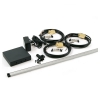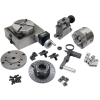Digital Position Readout (DRO) ComparisonA digital position readout (also known as a DRO, short for digital read out) provides a numerical display showing the position of your machine elements. On a milling machine a 3-axis DRO shows the X- and Y- positions of the mill table plus the Z-axis position of the cutting tool. On a lathe, a typical 2-axis DRO shows the positions of the carriage and the cross slide. DROs help prevent common errors such as misreading the hand wheel dials or losing count of hand wheel rotations. They also provide capabilities that are impossible with mechanical hand wheels and dials, such as switching from measuring inches to measuring millimeters. At LittleMachineShop.com, we carry several complete DRO packages. We have rotary encoder-based DRO packages that fit specific lathes. We have a selection of scale-based DRO packages that fit most bench top lathes and mills. Rotary encoder-base DRO's for LathesThese packages mount right on the cross slide, compound rest and tailstock to give you accurate depth of cut readings. Unlike our other DRO kits, these are not a true DROs. There are two things that differentiate these from a true DRO. First, they provide readouts for the cross slide and the compound rest. They do not display the position of the carriage at all. Second, they do not actually measure the position of the cross slide or the compound rest, but measure turns of the hand wheels. Why are these distinctions important? The first is pretty obvious, if you want to know where your lathe carriage is. This product won't help. But if you want to measure along the axis of the bed, you can set the compound rest perpendicular to the cross slide and use it to measure. The second distinction is a finer point. Because this product measures turns of the hand wheel, there is no compensation for backlash. On a milling machine this would make this product pretty much useless. But on a lathe, you are always cutting in the same direction (on any particular cut), so backlash doesn't matter.
This product is a good value. It provides most of the features of a 'real' DRO at a very attractive price. But don't try to use it on anything but the lathe it was designed for. It simply won't work. Rotary Encoder-Based DRO Package Comparison Table
Scale-Based DRO PackagesThese DRO packages include the digital display unit, 2 or 3 scales, mounting hardware, and complete instructions for installation and use. Except for packages that are designed for a specific machine, scale-based DRO packages are designed to mount on any machine within the range of the scales. They all come with 'universal' mounting brackets. These mounting brackets are probably all you need to mount the DRO on large machines. On smaller machines (including mini lathes and mini mills) you will probably need to make some mounting brackets. Note that the Bluetooth DRO packages, except the universal models, come with all the brackets required for the machines they support. All scale-based DRO installations require drilling and tapping a number of holes in the machine. The biggest challenge is usually the cross slide on small lathes and the X-axis on small mills. On small lathes, the answer is sometimes to mount the DRO scale hanging in space behind the cross slide. On small mills, the smaller cross section of the Bluetooth and the DRO Pros magnetic scales can make it significantly easier to mount the X-axis scale behind the table without restricting the table travel. Glass scales are a challenge to mount on small machines because of their large cross-section and fixed lengths.
Scale-Based DRO Package Comparison TableThis table includes one DRO package representing each class of DRO. The specs for the other packages in the same class are the same.
Common features of DROs include:
|






 Rotary Table, 4" Digital Readout with Tailstock, Dividing Plate, & 3-Jaw Lathe Chuck
Rotary Table, 4" Digital Readout with Tailstock, Dividing Plate, & 3-Jaw Lathe Chuck Cut-Off Blade, P1
Cut-Off Blade, P1
